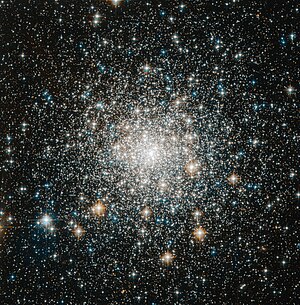M70
M70或梅西耶70,也称为NGC 6681,是在人马座南侧的一个球状星团[a]。梅西耶在1780年8月31日发现它[5]。著名的海尔·波普彗星在1995年7月23日被发现时,就在它的旁边[8]。
| M 70 | |
|---|---|
 | |
| 观测数据(J2000 历元) | |
| 分类 | V[1] |
| 星座 | 人马座 |
| 赤经 | 18h 43m 12.76s[2] |
| 赤纬 | –32° 17′ 31.6″[3] |
| 距离 | 29.4 kly(9.0 kpc)[4] |
| 视星等 (V) | +9.06[3] |
| 视直径(V) | 8.0′[5] |
| 物理性质 | |
| Mass | 1.79×105[4] M☉ |
| 半径 | 34 ly[6] |
| 金属量 | –1.35[7] dex |
| 估计年龄 | 12.80 Gyr[7] |
| 其它名称 | GCl 101, M70, NGC 6681[3] |
它与地球的距离为29,400光年[4],并以6,500光年的距离绕着银河中心运转[9]。它的大小和亮度与同在人马座的邻居,也是球状星团的M69大致相同[10]。M70的核心非常小,半径大约只有0.22 ly(0.068 pc)[11],半光度的半径则为182.0 ly(55.80 pc)[12]。该星团经历了核心崩塌,使其质量集中于中心[13],光度分布遵循幂定律[9]。
星团中有两个不同的恒星群体,每一个群体都显示出独特的丰度[14]。已知有五颗变星位于其广泛的半径,即潮汐半径内,所有的这些变星都是天琴座RR型变星[15][16]。这个星团在核心附近可能有两颗蓝离散星 [9]。
图集
编辑-
哈伯太空望远镜拍摄的M70。
-
以箭头标示出M70的星图,在正常状况下,地平线的位置在图的南方(下方) (罗伯托·穆拉) 。
参考资料和注解
编辑- ^ Shapley, Harlow; Sawyer, Helen B., A Classification of Globular Clusters, Harvard College Observatory Bulletin, August 1927, 849 (849): 11–14, Bibcode:1927BHarO.849...11S.
- ^ Goldsbury, Ryan; et al, The ACS Survey of Galactic Globular Clusters. X. New Determinations of Centers for 65 Clusters, The Astronomical Journal, December 2010, 140 (6): 1830–1837, Bibcode:2010AJ....140.1830G, arXiv:1008.2755 , doi:10.1088/0004-6256/140/6/1830.
- ^ 3.0 3.1 3.2 [ NGC 6681] 请检查
|url=值 (帮助). SIMBAD. 斯特拉斯堡天文资料中心. - ^ 4.0 4.1 4.2 Boyles, J.; et al, Young Radio Pulsars in Galactic Globular Clusters, The Astrophysical Journal, November 2011, 742 (1): 51, Bibcode:2011ApJ...742...51B, arXiv:1108.4402 , doi:10.1088/0004-637X/742/1/51.
- ^ 5.0 5.1 Adam, Len, Imaging the Messier Objects Remotely from Your Laptop, The Patrick Moore Practical Astronomy Series, Springer: 304, 2018, Bibcode:2018imor.book.....A, ISBN 978-3319653853
- ^ distance × sin( diameter_angle / 2 ) = 34 ly. radius
- ^ 7.0 7.1 Forbes, Duncan A.; Bridges, Terry, Accreted versus in situ Milky Way globular clusters, Monthly Notices of the Royal Astronomical Society, May 2010, 404 (3): 1203–1214, Bibcode:2010MNRAS.404.1203F, arXiv:1001.4289 , doi:10.1111/j.1365-2966.2010.16373.x.
- ^ Mobberley, Martin, It Came From Outer Space Wearing an RAF Blazer!: A Fan's Biography of Sir Patrick Moore, Springer Science & Business Media: 483, 2013, ISBN 978-3319006093
- ^ 9.0 9.1 9.2 Watson, Alan M.; et al, Far-ultraviolet imaging of the globular cluster NGC 6681 with WFPC2 (PDF), Astrophysical Journal, Part 2, November 1994, 435 (1): L55–L58 [2021-08-12], Bibcode:1994ApJ...435L..55W, doi:10.1086/187593, (原始内容存档 (PDF)于2022-10-06).
- ^ Frommert, Hartmut; Kronberg, Christine, Globular Cluster M70, SEDS Messier pages (Students for the Exploration and Development of Space (SEDS)), 30 August 2007 [2018-12-04], (原始内容存档于2015-03-03).
- ^ Djorgovski, S., Physical Parameters of Galactic Globular Clusters, Djorgovski, S. G.; Meylan, G. (编), Structure and Dynamics of Globular Clusters. Proceedings of a Workshop held in Berkeley, California, July 15–17, 1992, to Honor the 65th Birthday of Ivan King 50, San Francisco, California: Astronomical Society of the Pacific: 373, January 1993, Bibcode:1993ASPC...50..373D, ISBN 978-0937707692.
- ^ Forbes, Duncan A.; et al, Uniting old stellar systems: from globular clusters to giant ellipticals, Monthly Notices of the Royal Astronomical Society, October 2008, 389 (4): 1924–1936, Bibcode:2008MNRAS.389.1924F, arXiv:0806.1090 , doi:10.1111/j.1365-2966.2008.13739.x.
- ^ Pryor, Carlton; et al, Mass-to-light ratios for globular clusters. I - The centrally concentrated clusters NGC 6624, M28 (NGC 6626), and M70 (NGC 6681), Astronomical Journal, August 1989, 98: 596–610, Bibcode:1989AJ.....98..596P, doi:10.1086/115160.
- ^ O'Malley, Erin M.; et al, High-resolution Spectroscopic Abundances of Red Giant Branch Stars in NGC 6681, The Astrophysical Journal, September 2017, 846 (1): 15, Bibcode:2017ApJ...846...23O, arXiv:1706.06962 , doi:10.3847/1538-4357/aa7b72, 23.
- ^ Liller, M. H., The variable stars in the field of the globular cluster NGC 6681, Astronomical Journal, October 1983, 88: 1463–1469, Bibcode:1983AJ.....88.1463L, doi:10.1086/113435.
- ^ Clement, Christine M.; et al, Variable Stars in Galactic Globular Clusters, The Astronomical Journal, November 2001, 122 (5): 2587–2599, Bibcode:2001AJ....122.2587C, arXiv:astro-ph/0108024 , doi:10.1086/323719.
外部链接
编辑- Messier 70, Galactic Globular Clusters Database page (页面存档备份,存于互联网档案馆)
- WikiSky上关于M70的内容:DSS2, SDSS, GALEX, IRAS, 氢α, X射线, 天文照片, 天图, 文章和图片